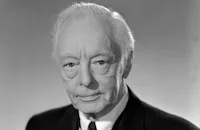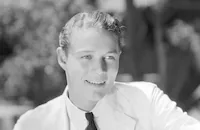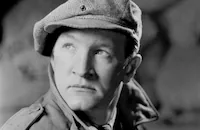G. I. War Brides
Brief Synopsis
Cast & Crew
George Blair
Anna Lee
James Ellison
Harry Davenport
William Henry
Stephanie Bachelor
Film Details
Technical Specs

Synopsis
At the United States Department of Justice's Immigration and Naturalization Service, an official shows the British-born war bride Beatrice Moraski a picture of another war bride, who claims to be Beatrice's sister, Joyce Giles, but who the inspector suspects is an impostor. When the inspector threatens to revoke Beatrice's right to live in the United States, she confesses that the woman in the picture is not her sister. Beatrice admits that she knows the pictured woman, Linda Powell, and tells the inspector that her sister forfeited her passage to the United States because she was not in love with her American husband Steve. Beatrice then tells the story of how she and Linda met and how she became involved in helping Linda travel in Joyce's stead: Moments before sailing for America, Joyce tells her sister that she does not wish to be reunited with a man she hardly knows, and refuses to make the voyage. When Beatrice finds Linda hiding in her ship cabin, Linda shows her a beautiful letter written by her American sweetheart, Capt. Roger Kirby. Realizing that Linda is truly in love, Joyce allows Linda to assume her identity for immigration purposes. During the ocean crossing, Dawson, a newspaper photographer who took a picture of Beatrice and Joyce at the English dock, suspects, but cannot prove, that Linda is not the same woman he photographed. Dawson believes he has stumbled upon a provocative story but decides to wait to expose the lie until his film is developed in New York. After arriving in New York, Linda passes through an immigration inspection with the help of Beatrice, who causes a diversion by feigning illness. En route to Los Angeles, Linda becomes worried when she learns that the war brides will not be free to go until their husbands sign for them. At the Los Angeles train station, under the watchful eye of Dawson and the immigration officials, Steve agrees to give Linda a welcoming hug and sign her release. Linda thanks Steve for helping her and immediately telephones Roger in San Francisco, unaware that he has forgotten her and has found another girl friend. Roger agrees to meet Linda, regardless, and takes the next train to Los Angeles. While waiting for Roger to arrive, Linda joins Steve on a sightseeing tour of Los Angeles, and they soon fall in love. Roger shows little interest in Linda when he arrives, and Linda soon realizes that Roger does not love her. Believing that the demise of her relationship with Roger will result in her deportation, Linda prepares to turn herself in to immigration officials. Beatrice concludes her story by telling the inspector that Linda was picked up by immigration officials on her way to turn herself in to them. The immigration inspector, aware of the unusual circumstances of Linda's presence in America, treats Linda with leniency and allows her to return to England without pressing charges against her. When Steve finds out about Linda's deportation, he races to the train station and proposes to her. Linda accepts Steve's proposal and looks forward to a new life in America with the man she loves.

Director
George Blair
Cast

Anna Lee

James Ellison

Harry Davenport

William Henry
Stephanie Bachelor

Doris Lloyd

Robert Armstrong

Joseph Sawyer
Mary Mcleod
Carol Savage
Pax Walker
Helen Gerald
Pat O'moore
Maxine Jennings

Russell Hicks
Francis Pierlot

Pierre Watkin
Eugene Lay
Lois Austin
Virginia Carroll
Robert Bice
Lester Dorr
Mary Newton
Beatrice Gray
Clarence Straight
Guy Kingsford
Gene Garrick
Dave Daggett
Michael Hughes
Fred Toones
Pat Flaherty
Jack Norman
Tristram Coffin
Stephen Barclay
Victor Sen Yung
Bruce Langley
Charles Sullivan
David Reed
Jesse Graves
Ed Ramsey
Robert Wayne
Petra Silva
Crew
Hilyard Brown
Robert Burns
John K. Butler
Ralph Butler
Thomas A. Carman
Mack D'agostino
Joseph Dubin
Ernest Gold
John Grubbs
Alfred Keller
Howard Lydecker
Theodore Lydecker
Bob Mark
Tony Martinelli
John Mccarthy Jr.
Al Myers
Lewis Physioc
Armand Schaefer
Gordon Schaefer
Morton Scott
Fred Stahl
John Stransky Jr.
Barbara Walker
Raymond Wallace
Howard Wilson
Earl B. Wooden

Film Details
Technical Specs

Quotes
Trivia
Notes
According to a February 25, 1946 Hollywood Reporter news item, producer Armand Schaefer was to interview a group of war brides, who had recently arrived from England, about their experiences. Although Ernest Gold is credited onscreen with composing the film's music score, all other contemporary sources credit Joseph Dubin.












